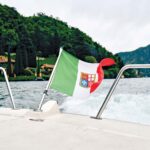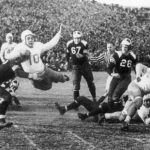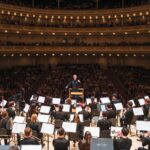From Sea to Sky: Galápagos to Machu Picchu, Part 2
Pat Cook, BA ’73, Life Member, roamed the Galápagos Islands and Machu Picchu last month with the Flying Longhorns. In Part 1, Cook reflected on the wondrous wildlife he encountered on the Galápagos Islands—from puffed-up frigatebirds to giant tortoises. In Part 2, he makes his way to majestic Machu Picchu.
The journey to the Galápagos Islands was really nostalgic for me. My dad was stationed on the Galápagos for four years during World War II, a curiosity and a mystery to me. Still, he seemed to like it and it dramatically affected my whole life. His exposure to Latin culture was so positive it caused him to jump at the first opportunity after the war to return, which is how I spent the formative years of my childhood in Puerto Rico. That became a big part of who I am, so I wanted to see where it all started. You see the Galápagos Islands on National Geographic specials all the time—you know, with the iguanas, boobies, giant turtles, sea lions, and such. What the heck was Dad doing defending these volcanic rocks off of Ecuador from the Japanese? Thus was born the genesis of my trip.
The transition to Peru is where the trip ran into some trouble. Packing two weeks of clean underwear is tough enough, but packing for two entirely different climates is crazy. We left the Galápagos for Cuzco, Peru, which is Denver times two—Cuzco is the two-mile-high city. The rules are: Take your meds, walk slowly, and stop frequently—or die. We’re both glad we went on to Machu Picchu, but neither of us thought it was easy.
While the first week featured a cruise ship, three regular meals, air conditioning, and measured trips under good supervision, the second week in Peru was a real march. First, we dropped off a suitcase in Lima with our water and tropical gear for storage since hauling it up to Cuzco—12,000 feet—seemed silly. Shorts and sandals and swimwear were jettisoned.
Peru is really quite different from Ecuador. Ok, they use dollars too, but otherwise, I found it quite different. While Ecuador makes no bones about using the dollar as their currency, the Peruvians are not so committed. Nearly everything is priced in dollars, and the ATMs actually give you a choice of getting your currency in either dollars or soles—a sol is about $0.30. Still, they do go to the trouble of printing the stuff. I managed to avoid contact with it for almost a week.
Machu Picchu is the major tourist destination in Peru, and Cuzco is gearing up for the tourist travel. In Peru they have a serious sweater trade, which is a good thing for me. All my sweaters died this winter so I bought all new alpaca sweaters in Peru. I purchased enough to knit my own alpaca if I want, though another variety, the vicuna, produces the very best wool, which leads to an interesting story. Everyone used to go out and trap the vicunas and they were in decline. So, the government passed a law that you could capture a vicuna, but then you had to keep it for two years before you could shear it, then you had to let it go. People would round up the vicunas, keep them for a couple of years, and shear them, releasing them back into the wild in a bad mood. Thus there are all of these half-naked vicunas wandering around with sour expressions on their faces.
On nearly all of the roofs of houses in Peru there are little shrines. They consist of a polyglot of symbols, two oxen, a cross, a shovel, a flag or two, and more. Before the Spanish came, the only significant mammals were the llama, the guinea pig, and an odd dog or two. People ate the llamas and guinea pigs, known locally as “cuy” and pronounced “coo-ee.” They still do. I ate both and I survived. The reason for the oxen symbols on the house shrines is that this is primarily an agricultural society and they had no large draft animals until the Spanish showed up with oxen. The Peruvians positively fell in love with a large animal that could be used to replace human labor for farm work and thought it was the coolest thing they had ever seen. Perspective. It’s all about perspective. Perspective is Peruvian for making small images of oxen and putting them on the roofs of your houses.
The cuy is still universally eaten in Peru, although it has yet to catch on well with tourists. After all, it is a guinea pig. You can see them on spits roasting at roadside stands, which is an interesting sight. The most amazing integration of cultures was when we visited a large Catholic Church in Cuzco. In a large painting of “The Last Supper,” Jesus was depicted presiding over a roasted cuy with his twelve disciples. Hey, I’m all for acceptance.
 More on food, the kinds that did catch on elsewhere: Mexico was the origin of corn. Peru, on the other hand, was the birthplace of the potato. They still boast more than 300 varieties of potatoes in Peru. We went into native markets and found sacks and sacks of every description of potato you could imagine. I’ve had meals in Ireland that actually had four or five kinds of potatoes on the same plate. God bless the Peruvian potato. I’m sure it would have been at the Last Supper if they had painters there recording the scene.
More on food, the kinds that did catch on elsewhere: Mexico was the origin of corn. Peru, on the other hand, was the birthplace of the potato. They still boast more than 300 varieties of potatoes in Peru. We went into native markets and found sacks and sacks of every description of potato you could imagine. I’ve had meals in Ireland that actually had four or five kinds of potatoes on the same plate. God bless the Peruvian potato. I’m sure it would have been at the Last Supper if they had painters there recording the scene.
Getting to Machu Picchu means leaving more stuff in storage in Cuzco and taking a bus and train to the base of the mountain. We now had our stuff divided into three separate lots scattered over the country. We only took small two-day bags of stuff to Machu Picchu; this turned out to be a problem.
We had a hotel at the base of the mountain at the end of the train ride from Cuzco. Getting up the mountain means taking a switchback bus ride (13 switchbacks; I counted) up a dirt road, in the rain, to the base of the mountain city. It is recommended that you don’t look down during the bus ride. It is especially recommended that you don’t look out when your bus is backing up to a wide spot in order to let an oncoming bus get by on what is essentially a one-lane road.
Machu Picchu is an ancient city built over many generations by stonemasons, from large stones which had to be transported up to a ridge 14,000 feet up in the Andes. It seems now, as earlier guesses were too fantastic, that the site was actually dedicated to rain and their gods were lightning and thunder. It was, after all, an agricultural society and rain was determined to be a useful element to their survival. The first day we were there, we went up as a group, and stayed until the rain nearly washed us off the mountain. The gods were more than happy. As we had left most of our clothes back in Cuzco, we were all drenched and spent the evening drying our clothes out with the hotel hair dryers. Susan’s pants, unfortunately, were hair dryer– resistant and stubbornly remained wet for days. Dinner was uncomfortable that night so I ate cuy to cheer myself up.
As it rained so much, I realized that our electronic innovations have their limitations. I was carrying a backpack with a laptop, an iPad, an iPhone, and a DSLR, which is, of course, an electric camera. I also discovered my rain jacket was not waterproof, just merely water resistant, and that means everything got wet eventually. Anyway, we had the following morning to go back on our own, which I did, and to my amazement, it was beautiful. Fog and clouds passed over the ridge where Machu Picchu is located, creating a beautiful and mysterious photographic experience. I would have been disappointed otherwise. Disappointment is not one of my favorite emotions.
 Having lived for nearly 50 years in Houston, Machu Picchu couldn’t have been much more different. Houston is flat and has an average elevation of 70 feet or so. At 14,000 feet, the residents of Machu Picchu spent years creating tiny terraces clinging to vertical mountainsides where they had a few feet of flat ground to grow their potatoes. In Houston you look up to see the clouds, and in Machu Picchu, you look down.
Having lived for nearly 50 years in Houston, Machu Picchu couldn’t have been much more different. Houston is flat and has an average elevation of 70 feet or so. At 14,000 feet, the residents of Machu Picchu spent years creating tiny terraces clinging to vertical mountainsides where they had a few feet of flat ground to grow their potatoes. In Houston you look up to see the clouds, and in Machu Picchu, you look down.
I started this to tell you this was a journey of discovery for me, where I went to find a bit of my history. My life could have been dramatically different without this little part of the world. The crew on the ship in the Galápagos was talking about the U.S. Army being stationed there during the war. The island we first flew into to meet the ship was named Baltra, where the army had their base, and where my dad was stationed. They were laughing that the army actually built a movie theater on the island for the troops. That was about 1943, nearly eight years before I was born.
There is a story my dad used to tell me. A bunch of guys would get together and take a transport plane into Guayaquil on the weekends. Dad was going in one time and the plane was delayed, so after a while he gave up went to the movie. When he came out, the base commander was standing out in front of the theater and motioned to dad to come over. The plane had finally arrived and the guys going into Guayaquil looked all over for him but couldn’t find him, so they went on without him. The plane flew into the side of the mountains and they were all killed. Dad always looked a little misty when he told that story. My life could have been very, very different. You know, I’ve always loved the movies.
The Galápagos Islands and Machu Picchu are magical places. They are beautiful and rare, and you can find something special there, something that doesn’t exist like that anywhere else. The world is a book and if you don’t travel, you only read one page.





















No comments
Be the first one to leave a comment.